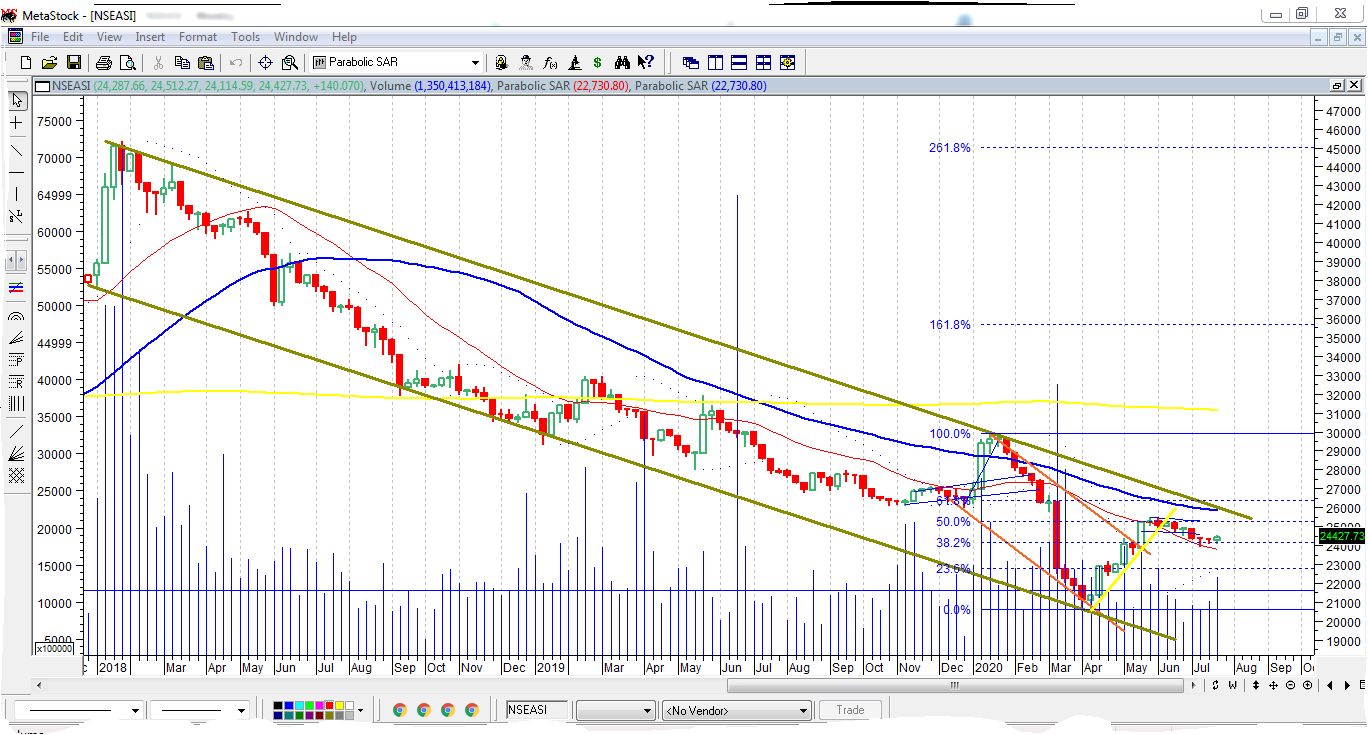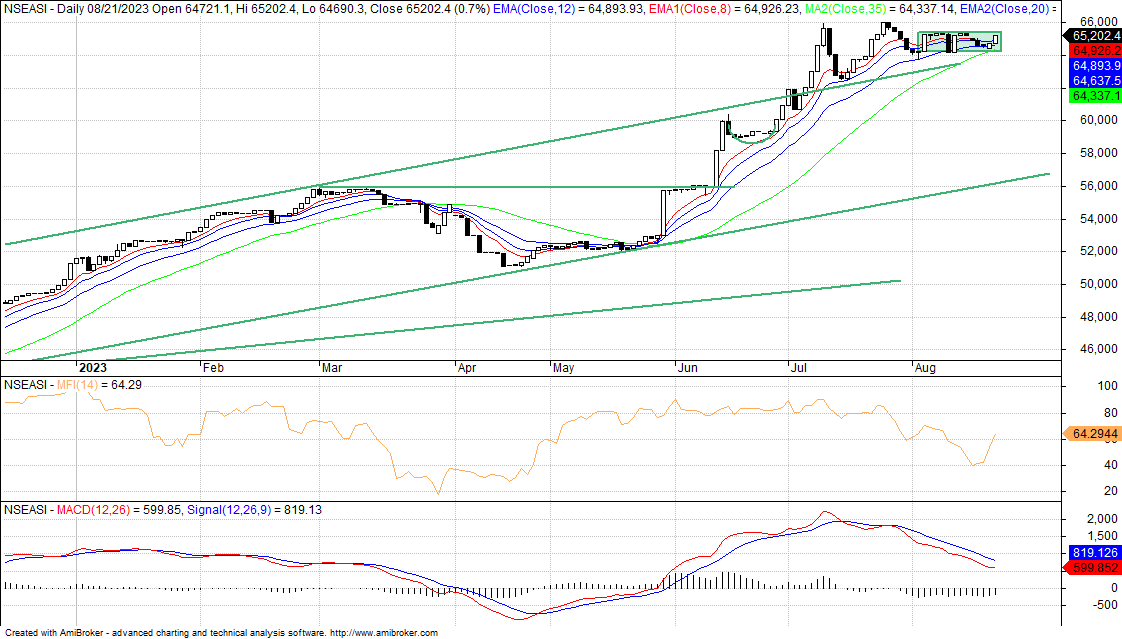Amid Mixed Outlook On Likely Pullbacks, Volatility May Linger On NGX In November
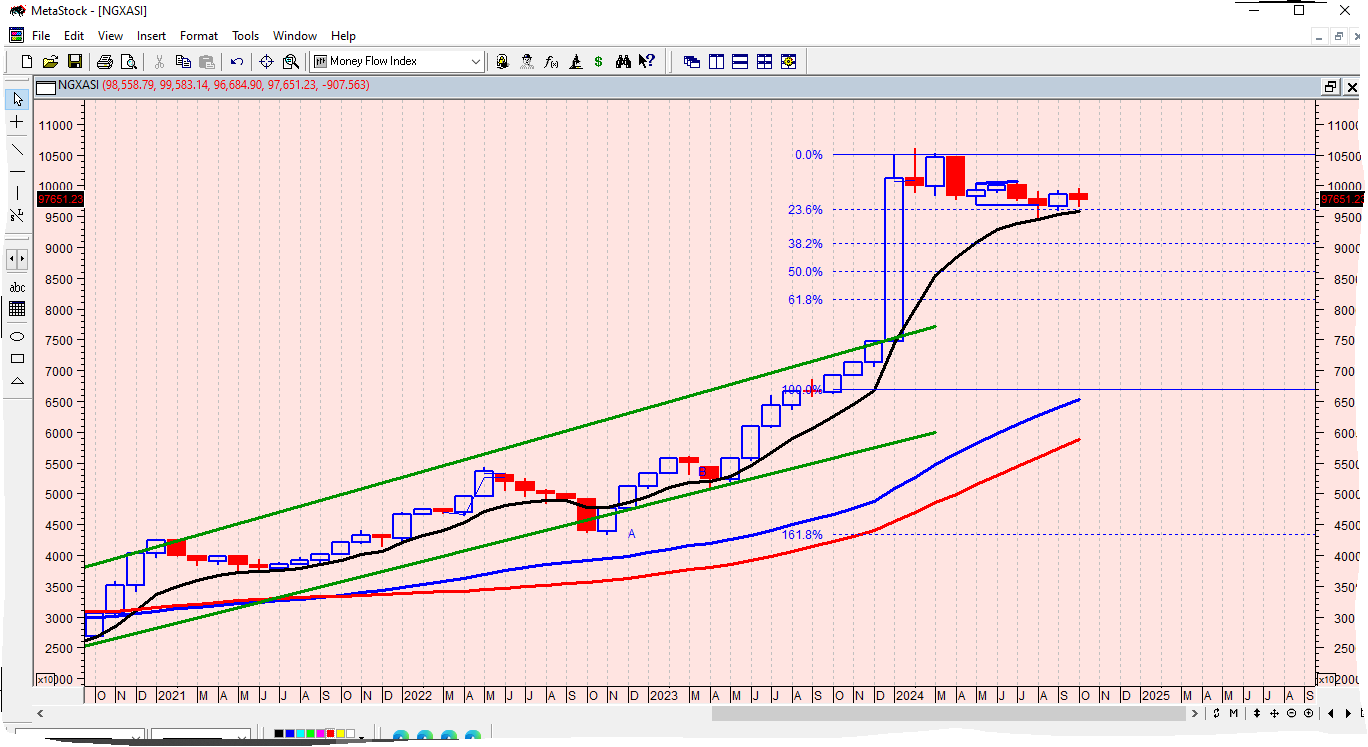
Market Roundup for October
Transactions on the Nigerian Exchange for the month of October, the earnings reporting season for mostly third quarter scorecards, closed on a negative note, after the composite NGX All-Share index lost 907.56 basis points on a selling sentiment, as investors seemingly ignored the mostly better-than-expected corporate reports. Also, they seem to have considered other factors more important than the low valuation of most stock that reveals higher upside potentials ahead of the year end seasonality and full year payout. Impressive numbers from some sectors point to the possibility of higher rewards which will likely impact positively on share prices.
One such consideration for the decline is the hyperinflationary environment that continues to threaten nearly all investment window, with inflation rate for the month of September at 32.70% and above the NGX’s year to date return and fixed income market yields. Recall that the nation’s GDP has been struggling to expand in the past two quarters, closing at 3.19% in Q2, even as all eyes are on the expected Q3 GDP report from the National Bureau of Statistics (NBS) ahead of November policy meeting of the Central Bank of Nigeria.
Selloffs in highly capitalized stocks, including the newly listed Aradel Holdings and profit taking in the last trading week of the month weighed heavily on the index as it reversed the previous gains, halting the recovery trend, even as the daily NGX index action formed a double bottom chart pattern that supports an uptrend on a very high traded volume and mixed sentiment.
October, the first month of the last quarter of 2024, ended in the red on Thursday, suggesting a trend continuation or reversal, even as the index is resisting further decline, judging by the candlesticks formation ahead of more earnings reports, and an eventual portfolio reshuffling along sectors and companies’ performance.
The bearish sentiments in the market was also despite the strong numbers emanating from some sectors and companies during the period, even amid crisis in the foreign exchange market and continued hike in energy prices. Globally, stock markets being major indicators of economic activities are forward-looking. Consequently, it is not unexpected that the current share prices are reflecting the future earnings potentials of quoted companies, or their profitability, which is directly linked to economic activities and eventually the GDP.
However, the Nigerian equity market has been oscillating since February on the back of selloffs and impressive earnings, leading to low stock valuations and mixed sentiments, while economic indices at the same time are weak and mixed as reflected in the quoted company’s earnings, despite the inconsistent policies of government.
The mixed trend by the benchmark NGX All-Share index and the positive corporate earnings of listed companies released so far shows a disconnection and slow growth of the economy. This is a reflection of monetary policy stance of CBN and mismatch economic reforms policies of the government in the midst of high interest rate and insecurity. However, for these high rates are threatening the nation economy expansion, it is time for government to revisit its various policies needed to boost the economy, while ensuring coordination with the monetary authoriti
es so as to check the wanton incidences of policies summersaults that have prevailed for years.
The impact of this was worsened by the increased electricity tariff and pump price of petrol, further pressuring the cost of goods and services when added to the high cost of other production variables that have almost crippled the manufacturing sector as reflected in the mixed earnings of companies in the real sector.The continued circular flow of funds and high yields in fixed income market in the face of strong numbers as many stocks trade below their 52-week highs to reveal upside potential. As noted earlier, the Q3 scorecards of various listed companies have given insights into the real state of the economy in Q3 and what the Q3 GDP will look like when published by the NBS before the next MPC meeting in November.
The possibility of reversal and uptrend from here is high, amid portfolio reshuffling on the strength of the Q3 numbers, just as investors would be assured of reward in the form of dividends when the full-year score-cards begin to flow into the market in the early days of 2025, as likelihood of dividend growth is high. It is expected that discerning investors and traders would take advantage of the relative low stock prices, year-end season and cycle to grow their income, ahead of major earnings season in the first quarter of 2025.
In the 22 trading sessions of October, the index recorded losses in 12 sessions and gains in 10 trading days, reducing year-to-date gain to 30.60%, even as we note that the undervalued state of quoted companies, judging by their fundamentals and the relatively high dividend yields may attract more inflows to the Nigerian stock market. This is given that many equities are having high margin of safety, thereby offering higher upside potentials again.
Meanwhile, the benchmark Index in the month shed a total of 907.56 basis points, closing at 97,651.23bps, after touching low of 96,684.90bps, from its highs of 99,583.14bps for the month, after opening at 98,558.79bps. This represented a 0.92% decline over the period on selloffs and buying interests that impacted negatively on the index and stock prices, pushing them further southward to breakdown various support levels of 98,680 and 97,323.51bps.
Total ‘sell’ volume for the month was 67% and buy position of 33%, extending the bear transition in the past quarter, while volume index for the period was 0.92 points. Market capitalization rose by a princely N2.53tr, closing at N59.17tr, from N56.64tr, representing a 4.47% appreciation in value, due to the listing of Aradel Holdings and other companies’ additional shares within the period. Market breadth for the month was positive with the advancers outnumbering decliners in the ratio of 54:44 to halt the previous month rebound due to factors mentioned above.
Mixed Sectorial Performance
Performance indexes across the sectors were mixed as the chart below shows that the NGX Industrial goods indexes impacted the market the most during the month, performing worse than the general market. The NGX Industrial and Consumer goods indexes lost 9.31% and 0.75% respectively, driven by selloffs and profit taking Dangote Cement, BUA Cement and others, while the NGX Oil/Gas index improved by 15.90%, followed by the NGX Banking, Pension, Insurance and NGX 30 with 4.78%, 4.77%, 4.01% and 0.18% respectively. These revealing investors’ positive sentiment and the clear decision among traders, as the market’s Price-to-Earnings ratio remains low and attractive.

Best And Worst Performing
The month’s best-performing stocks were low and medium cap stocks across different sectors, led by Transcorp, which gained 298.23% after the one-for-four share reconstruction undertaken by the company, made even better by its impressive Q3 numbers. It was followed by EUNISELL’s 76.21% gain; and the 69.28% notch by Mecure. University Press climbed 55.76%, on market sentiment; just as the share price of Seplat Energies soared 38.92%; among others.
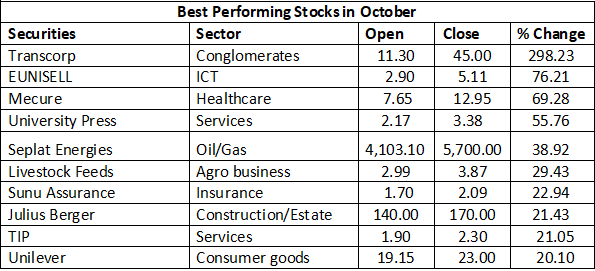
Source: Investdata Research
The worst performing stocks for the period was Regency Assurance, which lost 36%, amidst price adjustments for bonus shares and impressive earnings reports released recently; International Energy Insurance shed 14.84% also due to selloffs and profit taking; just as Caverton declined by 14.05%; ahead of UPDC’s 13.07% price decline during the month.
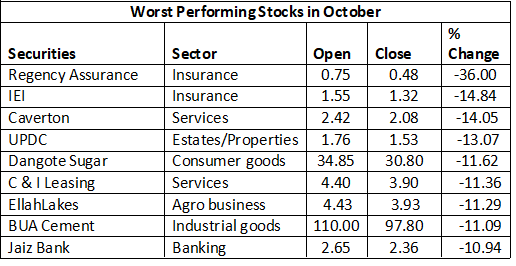
Source: Investdata Research
Technical View
The NGX’s index action for the month reveals a pullback and a bearish chart pattern that is resisting decline to trade above the T line and its 50-Day Moving Average on a monthly chart with selling sentiment and low traded volume. The market is still trading above the up channel, despite the buying interests witness also in the period , with the benchmark index entering the oversold region on a weekly and daily time frame to reflect decreased inflow of funds that pushed stock prices down in October, which was also the earnings reporting season. With the impressive numbers released, trading patterns and momentum, going forward, are likely to change amid portfolio rebalancing and repositioning ahead of year-end and seasonal cycles. Market technicals for the period were positive and this is expected to remain unchanged in the new month.
Market Outlook
Volatility is expected to continue in November, even as the outlook remains mixed due to likely price corrections, or pullbacks for a few days due to profit taking and portfolio reshuffling ahead of year-end and 2024 corporate actions. The anticipated correction in the new month will, however, strengthen recovery.
But investors at this point should not be greedy, but let their decisions be guided by preset investment goals and exit strategies, even as the healthy inflow of funds into the equity assets due to prevailing low rates in money market is likely to continue as the market look to the last MPC meeting for the year in the new month of November.
Again, the current undervalue state of the market offers investors opportunities to position for the short, medium and long-term, which is why investors should target fundamentally sound, and dividend-paying stocks for possible capital appreciation for the rest of the year.
Ambrose Omordion
CRO|Investdata Consulting Ltd
info@investdataonline.com
info@investdata.com.ng
ambrose.o@investdataonline.com
ambroseconsultants@yahoo.com
Tel: 08028164085, 08179547605



